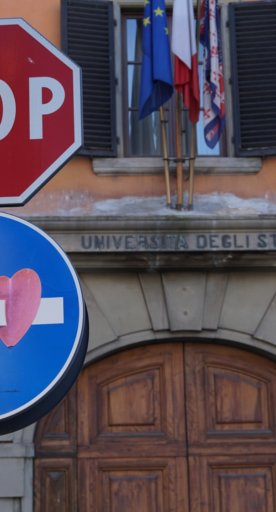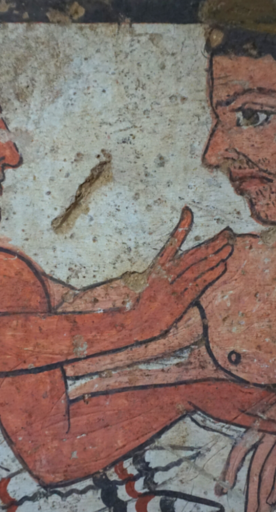LGBTQ + art at the Uffizi: masterpieces and myths in the rooms of the Gallery
A rainbow perspective to visit one of the most precious museums in Italy
The Uffizi Gallery in Florence houses works of inestimable value. In its 45 rooms, you can admire the masterpieces of Giotto, Sandro Botticelli and Leonardo da Vinci, to name just a few.
What many do not know is that it also houses works of art where you can discover a bit about LGBTQ+ culture and community. In this article, we'll give you some ideas for your next visit.
-
1.Busts of Hadrian and Antinous
-
2.Sleeping Hermaphroditus
-
3.Ganymede and the eagle
-
4.Pan and Daphnis
Busts of Hadrian and Antinous

The first works we want to talk to you about are the sculptures of Hadrian and Antinous. Made in the second century, they can both be found in the East Corridor of the Gallery.
The love story between Emperor Hadrian and the Greek Antinous has been handed down over time and remains one of the most interesting stories to explore ancient homosexual history. It's said that the two lovers, who were together for at least 5 years, lived their lives freely and openly.
The meeting between the two took place in 123 in Claudiopoli, in present-day Turkey. From that meeting onwards, Antinous was the Emperor's favorite and became part of the imperial entourage for all his travels.
In 128, the two left Rome for North Africa. Leaving from Rome, they arrived in Alexandria in Egypt in 130 and then moved to Heliopolis, near today's Cairo, and finally travelled up the Nile from there. The Nile was the cause of Antinous's death, which occurred near the oracle of Bes around 22 October 130, on the occasioin of the feast of Osiris, the god who dies and rises again. Antinous's death is shrouded in mystery and the most credited hypothesis is that the boy drowned after accidentally falling into the river.
The story is told in the famous novel by Marguerite Yourcenar, Memories of Hadrian.
Sleeping Hermaphroditus

The second work to know is that of the sleeping Hermaphrodite. The work is a Roman copy made from a Hellenistic original of the 2nd century BC and represents the sleeping son of Hermes and Aphrodite.
The story behind this sculpture, the myth of Hermaphroditus, is told by the Latin poet Ovid in book IV of Metamorphoses. A young man is the protagonist of the myth, who "as soon as he turned fifteen left the mountains of his native land" to discover the world. This boy, whose name is only discovered at the end of the story, was the son of Hermes, messenger of the gods, and Aphrodite, goddess of beauty and love. The young man is defined by Ovid as very beautiful and whose face revealed the unique features of those of his parents.
Arriving in Halicarnassus, the young man found himself near a water pond where the nymph Salmàcide lived. After seeing him, the nymph fell madly in love and, in order not to lose her love, she prayed to the gods: "May the day never come, oh gods, that he detaches from me and I from him!" and so it was that the gods satisfied her.
The bodies of the two merged into one, neither woman nor boy, who does not look like one or the other sex but has characteristics of both. And it's at this point that Ovid finally reveals the name of the new person, born from the union of the female body with the male one, Hermaphroditus.
Today, the young man rests in Room 38 of the Gallery, more commonly called the Room of the Hermaphrodite.
Ganymede and the eagle

Another work to admire and where you can learn about a very interesting myth with a strong LGBTQ+ appeal is Ganymede and the eagle, a Roman-era sculpture in Lunense marble located in Piazzale degli Uffizi.
Ganymede is described by Homer as the most beautiful boy among all mortals, so beautiful that even Zeus, the king of all gods, fell in love with him.
In the passages of the Iliad, it's said that Zeus decided to kidnap Ganymede. Disguised as a huge eagle, he clasped him with his claws and took him with him to Olympus. However, this unleashed the jealousy of Hera, goddess of marriage, marital fidelity and childbirth, as well as the wife of Zeus who saw Ganymede as a rival.
Zeus was so irritated by his wife's jealousy that he decided to transform Ganymede into the constellation of Aquarius, which can still be admired today next to that of the Eagle, the symbol of Zeus.
Pan and Daphnis

The last work and myth we have to tell you about is that of Pan and Daphnis. Daphnis, son of the nymph Daphnide and of the god Hermes and was famous for his beauty. He was immediately desired by Pan, who offered to instruct him by teaching him the art of singing and the use of the flute that Pan himself invented, called the syrinx or flute and made with reeds.
The sculpture, located in the Western Corridor of the Uffizi, depicts exactly this moment, with Pan intent on teaching the ancient art of the flute while embracing Daphnis in a somewhat innocent yet also mischievous way.
Pan was truly an excellent teacher, and Daphnis became so good at playing the flute that he in turn invented a new kind of poetry, which took the name of pastoral flute.









































